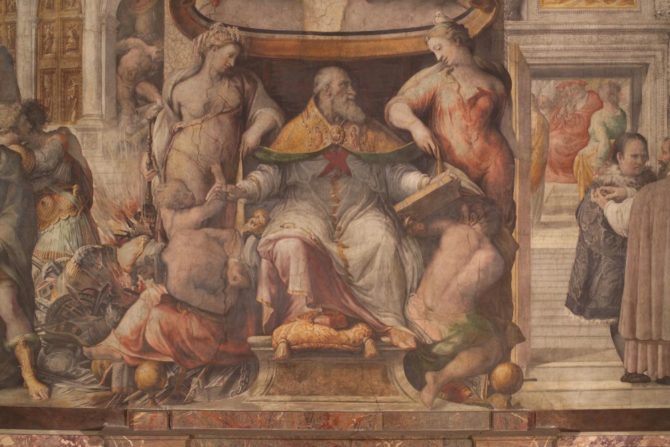Palazzo Farnese

Alessandro Farnese was made a cardinal at the age of 25, thanks to the influence of his sister, known as Giulia la Bella, Pope Alexander VI’s mistress. Alessandro commissioned a new residence in 1517, but when he was elected Pope Paul III in 1534, the whole concept of the Farnese family domus expanded. The greatest architects of the era, first Antonio da Sangallo the Younger, then Michelangelo, and later Vignola and Giacomo della Porta were brought in, and Palazzo Farnese is now generally acknowledged to be the finest Italian palace of the High Renaissance.
Since 1874 it has housed the French Embassy, and from December 17 to April 27 it will be open to the public, exclusively by reservation, for an exceptional exhibit, Palazzo Farnese, from the Renaissance to the French Embassy. For those few months, exquisite treasures collected and commissioned by the powerful and fabulously wealthy Farnese family will return from museums all over Europe to be seen again in their ancestral home.
Through marriage many Farnese treasures went to the Bourbon Kings of the Two Sicilies, and were transferred to Naples. Both the Capodimonte Museum and the National Archaeological Museum of Naples have contributed heavily to this temporary recreation of the Palazzo Farnese’s grandeur, with paintings, statues, drawings and sculptures that were once owned by the Farnese family.
In front of the palazzo, in the Piazza Farnese, water cascades from stone fleurs de lys—six make up the family crest—into huge tubs of Egyptian granite salvaged from the ruins of the Baths of Caracalla. Visitors will enter through the garden on the opposite side, facing Via Giulia parallel to the Tiber River. In the splendid courtyard, designed by Sangallo and completed by Michelangelo, virtual technology will create the illusion of ancient Farnese sculptures. Inside, visitors will enjoy a rare look at the vividly frescoed galleries and salons. Annibale Carracci’s magnificent gallery depicting the loves of gods and goddesses, where state dinners were once held, will be left empty, the better to marvel at the brilliant vitality of the ceiling.
The Farnese picture gallery will be reinstalled, with works including Titian’s masterful portrait of Pope Paul III and Marcello Venusti’s copy of Michelangelo’s Last Judgment, which guided the restoration of the Sistine Chapel’s altarpiece. From the Louvre, preparatory drawings by Carracci will be on view in Italy for the first time. Visitors with weekend or holiday tickets will also get to see the Ambassador’s office, the Salle des Fastes Farnésiens, the setting for Act II of Verdi’s opera Tosca.
Palazzo Farnese, from the Renaissance to the French Embassy. Through April 27, 2011. Closed Tuesdays. Reservations are obligatory at www.mostrapalazzofarnese.it or +39.06.32.810.
Originally published in the December 2010 issue of France Today
Share to: Facebook Twitter LinkedIn Email
Leave a reply
Your email address will not be published. Required fields are marked *




REPLY